Marketing Analysis and Strategies for the Hospitality Industry
VerifiedAdded on 2020/10/22
|13
|3616
|307
Report
AI Summary
This report provides a comprehensive analysis of marketing within the hospitality industry, using Thomas Cook Travel as a case study. It begins by defining the core concept of marketing and exploring its influence on the industry, including micro and macro environmental factors. The report then examines the significance of customer markets, market segmentation, and the application of the marketing mix (product, price, place, promotion) with a focus on pricing strategies. It delves into the role of the promotional mix, highlighting public relations, sales promotion, and advertising. Furthermore, the report emphasizes the importance of market research in service industry operations and concludes with an advertising campaign plan, demonstrating the practical application of marketing principles. The report covers key aspects such as market segmentation, pricing strategies, promotional mix, and the role of market research in the service industry. It provides insights into the application of marketing principles within the context of a real-world hospitality business, Thomas Cook Travel, offering a holistic view of marketing strategies within the industry.

Marketing In Hospitality
Industry
Industry
Paraphrase This Document
Need a fresh take? Get an instant paraphrase of this document with our AI Paraphraser
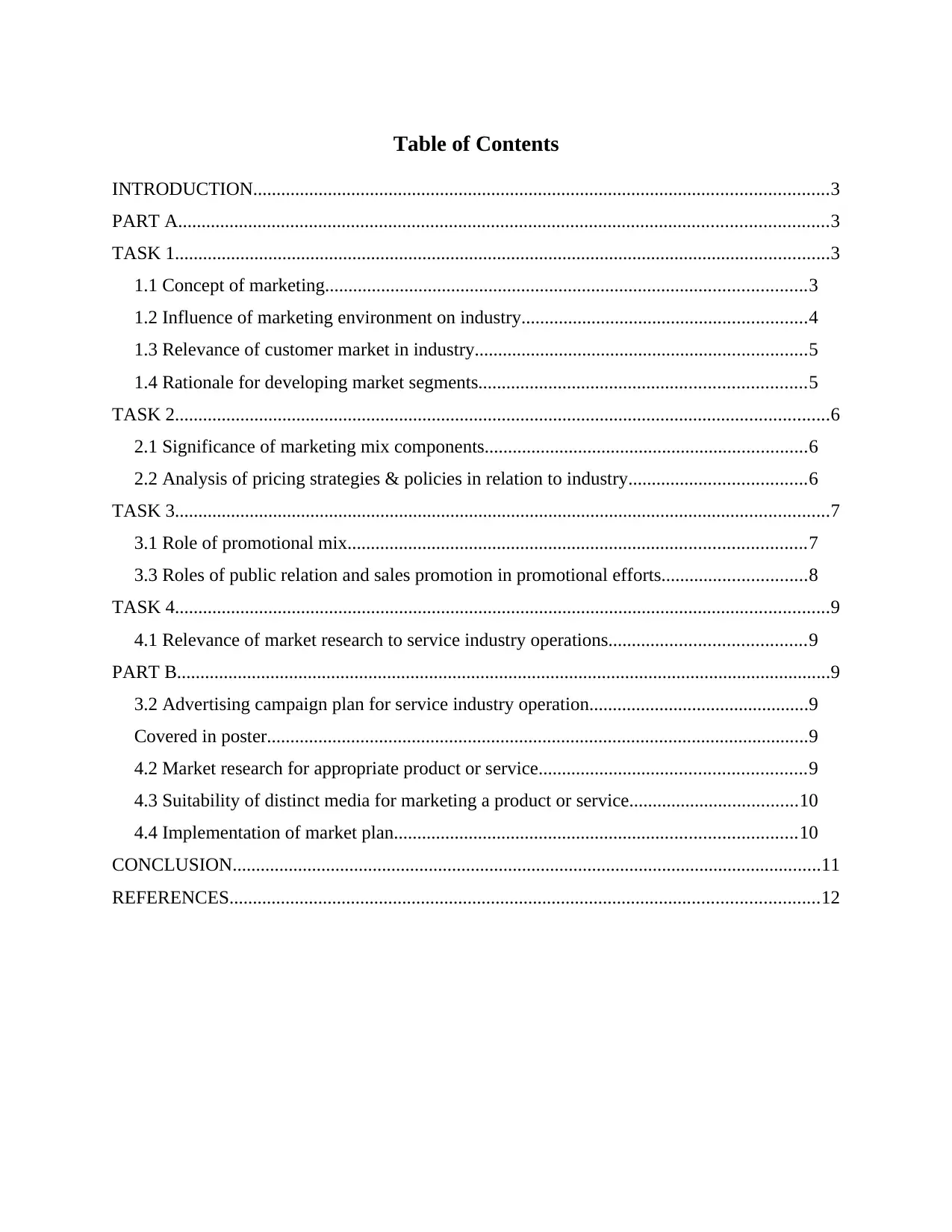
Table of Contents
INTRODUCTION...........................................................................................................................3
PART A...........................................................................................................................................3
TASK 1............................................................................................................................................3
1.1 Concept of marketing.......................................................................................................3
1.2 Influence of marketing environment on industry.............................................................4
1.3 Relevance of customer market in industry.......................................................................5
1.4 Rationale for developing market segments......................................................................5
TASK 2............................................................................................................................................6
2.1 Significance of marketing mix components.....................................................................6
2.2 Analysis of pricing strategies & policies in relation to industry......................................6
TASK 3............................................................................................................................................7
3.1 Role of promotional mix..................................................................................................7
3.3 Roles of public relation and sales promotion in promotional efforts...............................8
TASK 4............................................................................................................................................9
4.1 Relevance of market research to service industry operations..........................................9
PART B............................................................................................................................................9
3.2 Advertising campaign plan for service industry operation...............................................9
Covered in poster....................................................................................................................9
4.2 Market research for appropriate product or service.........................................................9
4.3 Suitability of distinct media for marketing a product or service....................................10
4.4 Implementation of market plan......................................................................................10
CONCLUSION..............................................................................................................................11
REFERENCES..............................................................................................................................12
INTRODUCTION...........................................................................................................................3
PART A...........................................................................................................................................3
TASK 1............................................................................................................................................3
1.1 Concept of marketing.......................................................................................................3
1.2 Influence of marketing environment on industry.............................................................4
1.3 Relevance of customer market in industry.......................................................................5
1.4 Rationale for developing market segments......................................................................5
TASK 2............................................................................................................................................6
2.1 Significance of marketing mix components.....................................................................6
2.2 Analysis of pricing strategies & policies in relation to industry......................................6
TASK 3............................................................................................................................................7
3.1 Role of promotional mix..................................................................................................7
3.3 Roles of public relation and sales promotion in promotional efforts...............................8
TASK 4............................................................................................................................................9
4.1 Relevance of market research to service industry operations..........................................9
PART B............................................................................................................................................9
3.2 Advertising campaign plan for service industry operation...............................................9
Covered in poster....................................................................................................................9
4.2 Market research for appropriate product or service.........................................................9
4.3 Suitability of distinct media for marketing a product or service....................................10
4.4 Implementation of market plan......................................................................................10
CONCLUSION..............................................................................................................................11
REFERENCES..............................................................................................................................12
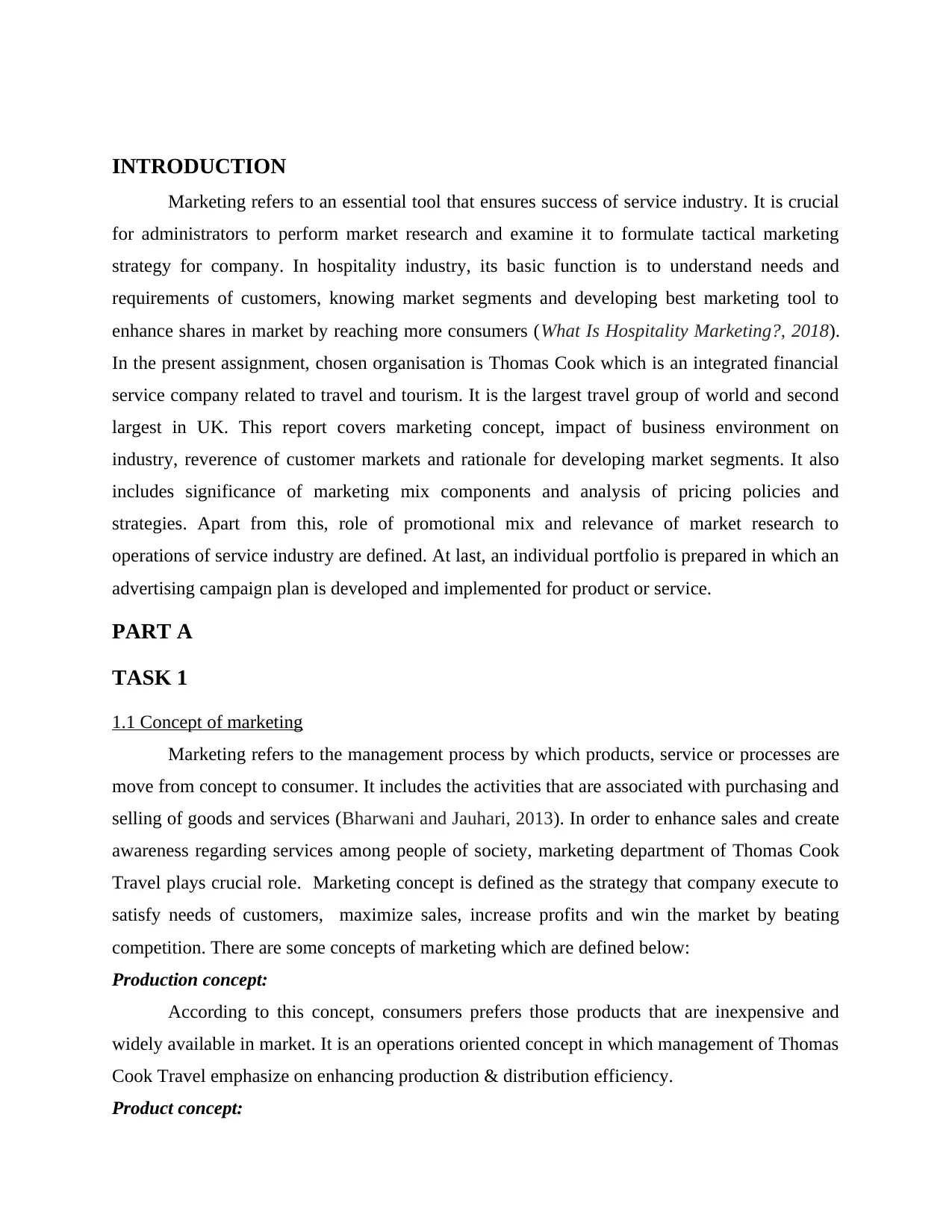
INTRODUCTION
Marketing refers to an essential tool that ensures success of service industry. It is crucial
for administrators to perform market research and examine it to formulate tactical marketing
strategy for company. In hospitality industry, its basic function is to understand needs and
requirements of customers, knowing market segments and developing best marketing tool to
enhance shares in market by reaching more consumers (What Is Hospitality Marketing?, 2018).
In the present assignment, chosen organisation is Thomas Cook which is an integrated financial
service company related to travel and tourism. It is the largest travel group of world and second
largest in UK. This report covers marketing concept, impact of business environment on
industry, reverence of customer markets and rationale for developing market segments. It also
includes significance of marketing mix components and analysis of pricing policies and
strategies. Apart from this, role of promotional mix and relevance of market research to
operations of service industry are defined. At last, an individual portfolio is prepared in which an
advertising campaign plan is developed and implemented for product or service.
PART A
TASK 1
1.1 Concept of marketing
Marketing refers to the management process by which products, service or processes are
move from concept to consumer. It includes the activities that are associated with purchasing and
selling of goods and services (Bharwani and Jauhari, 2013). In order to enhance sales and create
awareness regarding services among people of society, marketing department of Thomas Cook
Travel plays crucial role. Marketing concept is defined as the strategy that company execute to
satisfy needs of customers, maximize sales, increase profits and win the market by beating
competition. There are some concepts of marketing which are defined below:
Production concept:
According to this concept, consumers prefers those products that are inexpensive and
widely available in market. It is an operations oriented concept in which management of Thomas
Cook Travel emphasize on enhancing production & distribution efficiency.
Product concept:
Marketing refers to an essential tool that ensures success of service industry. It is crucial
for administrators to perform market research and examine it to formulate tactical marketing
strategy for company. In hospitality industry, its basic function is to understand needs and
requirements of customers, knowing market segments and developing best marketing tool to
enhance shares in market by reaching more consumers (What Is Hospitality Marketing?, 2018).
In the present assignment, chosen organisation is Thomas Cook which is an integrated financial
service company related to travel and tourism. It is the largest travel group of world and second
largest in UK. This report covers marketing concept, impact of business environment on
industry, reverence of customer markets and rationale for developing market segments. It also
includes significance of marketing mix components and analysis of pricing policies and
strategies. Apart from this, role of promotional mix and relevance of market research to
operations of service industry are defined. At last, an individual portfolio is prepared in which an
advertising campaign plan is developed and implemented for product or service.
PART A
TASK 1
1.1 Concept of marketing
Marketing refers to the management process by which products, service or processes are
move from concept to consumer. It includes the activities that are associated with purchasing and
selling of goods and services (Bharwani and Jauhari, 2013). In order to enhance sales and create
awareness regarding services among people of society, marketing department of Thomas Cook
Travel plays crucial role. Marketing concept is defined as the strategy that company execute to
satisfy needs of customers, maximize sales, increase profits and win the market by beating
competition. There are some concepts of marketing which are defined below:
Production concept:
According to this concept, consumers prefers those products that are inexpensive and
widely available in market. It is an operations oriented concept in which management of Thomas
Cook Travel emphasize on enhancing production & distribution efficiency.
Product concept:
⊘ This is a preview!⊘
Do you want full access?
Subscribe today to unlock all pages.

Trusted by 1+ million students worldwide
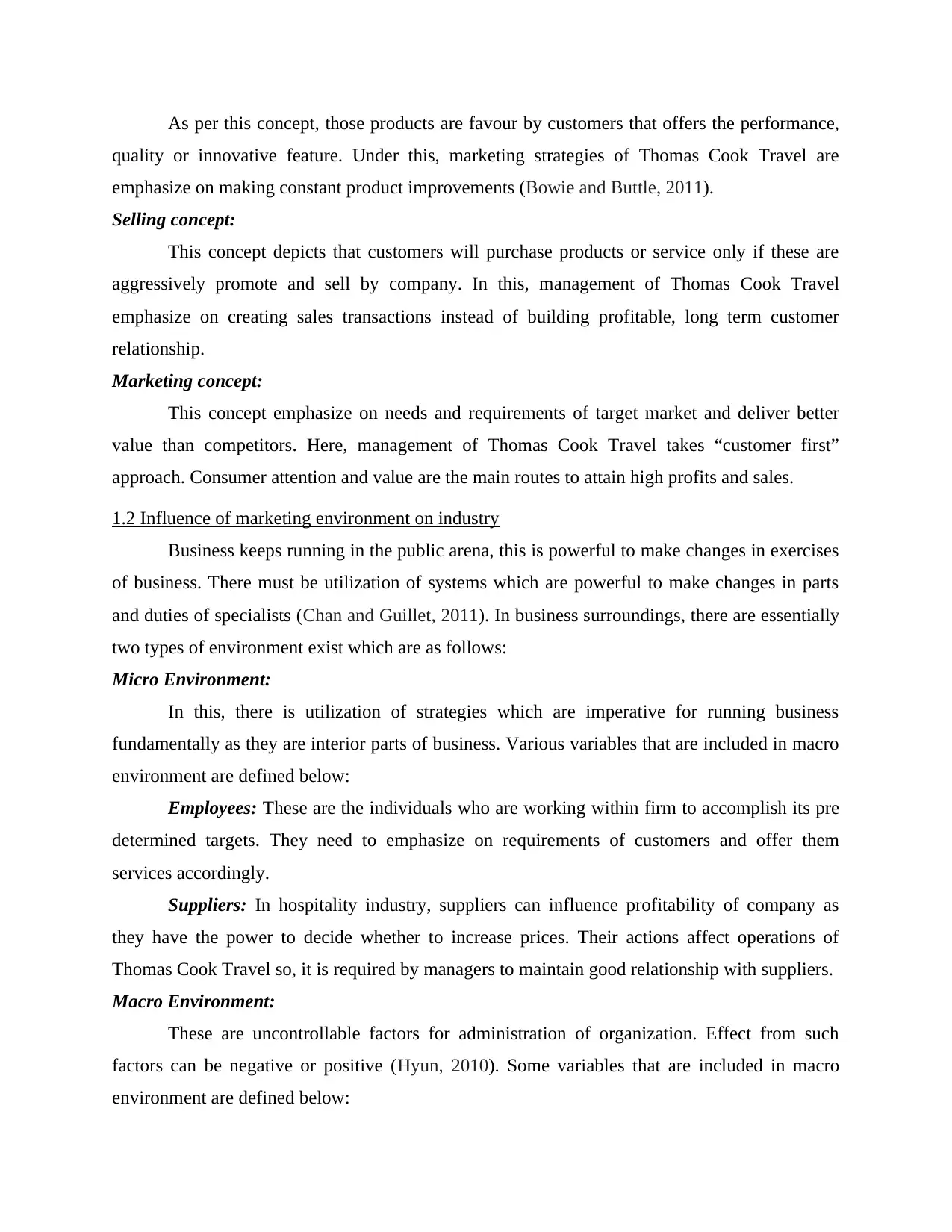
As per this concept, those products are favour by customers that offers the performance,
quality or innovative feature. Under this, marketing strategies of Thomas Cook Travel are
emphasize on making constant product improvements (Bowie and Buttle, 2011).
Selling concept:
This concept depicts that customers will purchase products or service only if these are
aggressively promote and sell by company. In this, management of Thomas Cook Travel
emphasize on creating sales transactions instead of building profitable, long term customer
relationship.
Marketing concept:
This concept emphasize on needs and requirements of target market and deliver better
value than competitors. Here, management of Thomas Cook Travel takes “customer first”
approach. Consumer attention and value are the main routes to attain high profits and sales.
1.2 Influence of marketing environment on industry
Business keeps running in the public arena, this is powerful to make changes in exercises
of business. There must be utilization of systems which are powerful to make changes in parts
and duties of specialists (Chan and Guillet, 2011). In business surroundings, there are essentially
two types of environment exist which are as follows:
Micro Environment:
In this, there is utilization of strategies which are imperative for running business
fundamentally as they are interior parts of business. Various variables that are included in macro
environment are defined below:
Employees: These are the individuals who are working within firm to accomplish its pre
determined targets. They need to emphasize on requirements of customers and offer them
services accordingly.
Suppliers: In hospitality industry, suppliers can influence profitability of company as
they have the power to decide whether to increase prices. Their actions affect operations of
Thomas Cook Travel so, it is required by managers to maintain good relationship with suppliers.
Macro Environment:
These are uncontrollable factors for administration of organization. Effect from such
factors can be negative or positive (Hyun, 2010). Some variables that are included in macro
environment are defined below:
quality or innovative feature. Under this, marketing strategies of Thomas Cook Travel are
emphasize on making constant product improvements (Bowie and Buttle, 2011).
Selling concept:
This concept depicts that customers will purchase products or service only if these are
aggressively promote and sell by company. In this, management of Thomas Cook Travel
emphasize on creating sales transactions instead of building profitable, long term customer
relationship.
Marketing concept:
This concept emphasize on needs and requirements of target market and deliver better
value than competitors. Here, management of Thomas Cook Travel takes “customer first”
approach. Consumer attention and value are the main routes to attain high profits and sales.
1.2 Influence of marketing environment on industry
Business keeps running in the public arena, this is powerful to make changes in exercises
of business. There must be utilization of systems which are powerful to make changes in parts
and duties of specialists (Chan and Guillet, 2011). In business surroundings, there are essentially
two types of environment exist which are as follows:
Micro Environment:
In this, there is utilization of strategies which are imperative for running business
fundamentally as they are interior parts of business. Various variables that are included in macro
environment are defined below:
Employees: These are the individuals who are working within firm to accomplish its pre
determined targets. They need to emphasize on requirements of customers and offer them
services accordingly.
Suppliers: In hospitality industry, suppliers can influence profitability of company as
they have the power to decide whether to increase prices. Their actions affect operations of
Thomas Cook Travel so, it is required by managers to maintain good relationship with suppliers.
Macro Environment:
These are uncontrollable factors for administration of organization. Effect from such
factors can be negative or positive (Hyun, 2010). Some variables that are included in macro
environment are defined below:
Paraphrase This Document
Need a fresh take? Get an instant paraphrase of this document with our AI Paraphraser

Political: Factors involves in this variables includes political stability, tax rates,
government policies etc. This factor may influence positively or negatively on business
operations of Thomas Cook Travel. So, firm requires to change their working style according to
any change takes place in political condition.
Economical: In order to run business activities and operations smoothly, finance is
required. So, firm requires to assess all the sources that are significant for company's growth.
Social: There is utilization of systems which help to function according to change in
responsibilities and duties of labourers to work as indicated by request.
Technological: As in Hospitality industry, there is upgraded check in check out process
and other services in which high end technology is utilized. This provides an ease to company in
offering its services in more better manner.
1.3 Relevance of customer market in industry
Customer market comprise of various individuals who takes choices with respect to what
to purchase or not. Each person who purchase products and service is known as buyer (Lee and
Kim, 2010). For deciding needs and prerequisites of customers, a model is implemented by
Thomas Cook Travel which is as follows:
Client culture: This aspect focuses on purchasing behaviour of customers. It includes
sociological and mental viewpoints. In order to determine this effectively, some aspects requires
to be assess by firm. These are:
Cultural: It is connected with culture as well as social class of customers.
Individual: This factor incorporates variables such as age, occupation, age, income and
lifestyle of customers.
Social: Family, status and so on are the variables that are incorporated into it which is
valuable for firm to recognize buying behaviour of clients.
Psychological: It includes attitude, beliefs, learnings and perceptions of individuals. All
these variables assists in determining behaviour of clients (Leung and et. al., 2013).
1.4 Rationale for developing market segments
Market Segmentation:
It refers to the process under which firm fragment its market into small homogeneous sub
divisions. Thomas Cook Travel
government policies etc. This factor may influence positively or negatively on business
operations of Thomas Cook Travel. So, firm requires to change their working style according to
any change takes place in political condition.
Economical: In order to run business activities and operations smoothly, finance is
required. So, firm requires to assess all the sources that are significant for company's growth.
Social: There is utilization of systems which help to function according to change in
responsibilities and duties of labourers to work as indicated by request.
Technological: As in Hospitality industry, there is upgraded check in check out process
and other services in which high end technology is utilized. This provides an ease to company in
offering its services in more better manner.
1.3 Relevance of customer market in industry
Customer market comprise of various individuals who takes choices with respect to what
to purchase or not. Each person who purchase products and service is known as buyer (Lee and
Kim, 2010). For deciding needs and prerequisites of customers, a model is implemented by
Thomas Cook Travel which is as follows:
Client culture: This aspect focuses on purchasing behaviour of customers. It includes
sociological and mental viewpoints. In order to determine this effectively, some aspects requires
to be assess by firm. These are:
Cultural: It is connected with culture as well as social class of customers.
Individual: This factor incorporates variables such as age, occupation, age, income and
lifestyle of customers.
Social: Family, status and so on are the variables that are incorporated into it which is
valuable for firm to recognize buying behaviour of clients.
Psychological: It includes attitude, beliefs, learnings and perceptions of individuals. All
these variables assists in determining behaviour of clients (Leung and et. al., 2013).
1.4 Rationale for developing market segments
Market Segmentation:
It refers to the process under which firm fragment its market into small homogeneous sub
divisions. Thomas Cook Travel
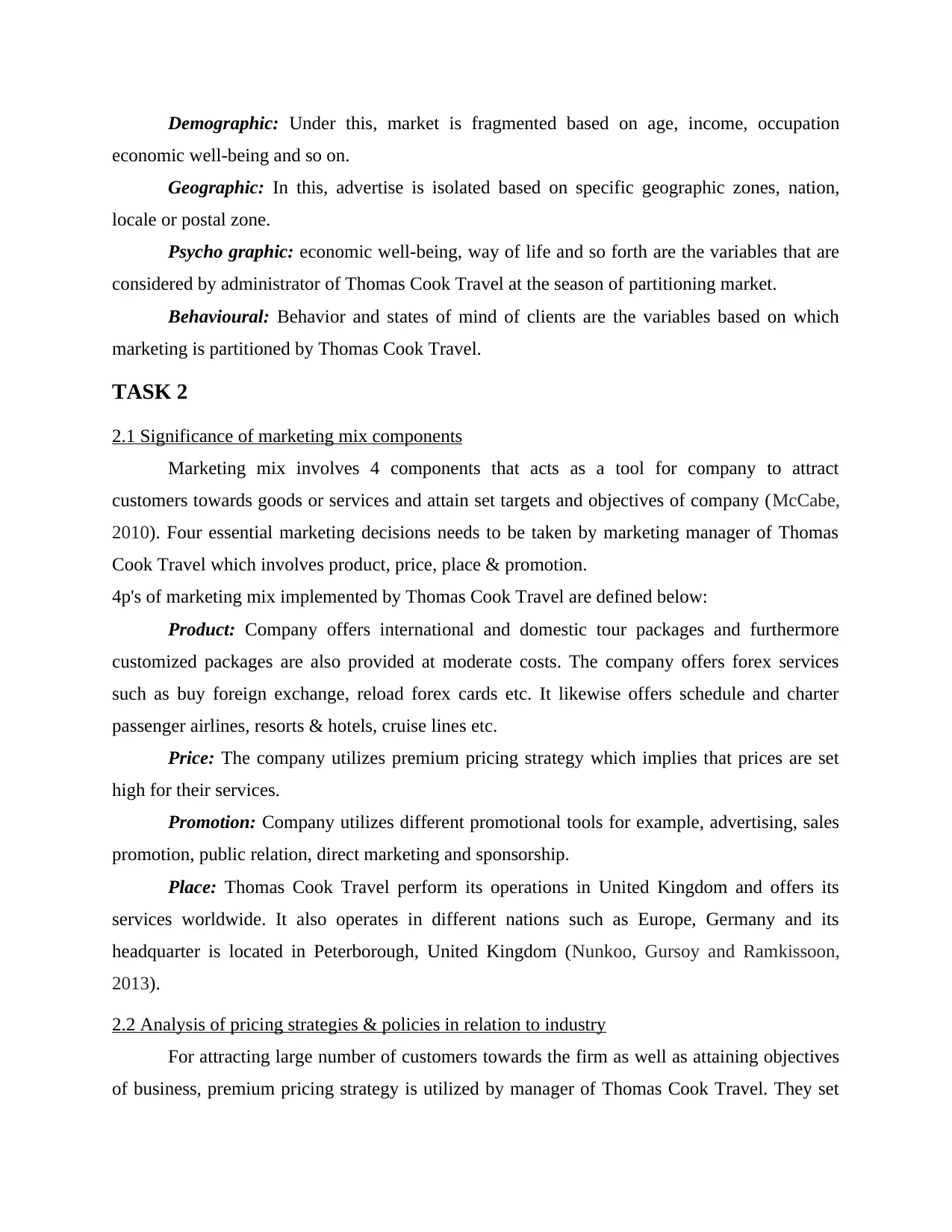
Demographic: Under this, market is fragmented based on age, income, occupation
economic well-being and so on.
Geographic: In this, advertise is isolated based on specific geographic zones, nation,
locale or postal zone.
Psycho graphic: economic well-being, way of life and so forth are the variables that are
considered by administrator of Thomas Cook Travel at the season of partitioning market.
Behavioural: Behavior and states of mind of clients are the variables based on which
marketing is partitioned by Thomas Cook Travel.
TASK 2
2.1 Significance of marketing mix components
Marketing mix involves 4 components that acts as a tool for company to attract
customers towards goods or services and attain set targets and objectives of company (McCabe,
2010). Four essential marketing decisions needs to be taken by marketing manager of Thomas
Cook Travel which involves product, price, place & promotion.
4p's of marketing mix implemented by Thomas Cook Travel are defined below:
Product: Company offers international and domestic tour packages and furthermore
customized packages are also provided at moderate costs. The company offers forex services
such as buy foreign exchange, reload forex cards etc. It likewise offers schedule and charter
passenger airlines, resorts & hotels, cruise lines etc.
Price: The company utilizes premium pricing strategy which implies that prices are set
high for their services.
Promotion: Company utilizes different promotional tools for example, advertising, sales
promotion, public relation, direct marketing and sponsorship.
Place: Thomas Cook Travel perform its operations in United Kingdom and offers its
services worldwide. It also operates in different nations such as Europe, Germany and its
headquarter is located in Peterborough, United Kingdom (Nunkoo, Gursoy and Ramkissoon,
2013).
2.2 Analysis of pricing strategies & policies in relation to industry
For attracting large number of customers towards the firm as well as attaining objectives
of business, premium pricing strategy is utilized by manager of Thomas Cook Travel. They set
economic well-being and so on.
Geographic: In this, advertise is isolated based on specific geographic zones, nation,
locale or postal zone.
Psycho graphic: economic well-being, way of life and so forth are the variables that are
considered by administrator of Thomas Cook Travel at the season of partitioning market.
Behavioural: Behavior and states of mind of clients are the variables based on which
marketing is partitioned by Thomas Cook Travel.
TASK 2
2.1 Significance of marketing mix components
Marketing mix involves 4 components that acts as a tool for company to attract
customers towards goods or services and attain set targets and objectives of company (McCabe,
2010). Four essential marketing decisions needs to be taken by marketing manager of Thomas
Cook Travel which involves product, price, place & promotion.
4p's of marketing mix implemented by Thomas Cook Travel are defined below:
Product: Company offers international and domestic tour packages and furthermore
customized packages are also provided at moderate costs. The company offers forex services
such as buy foreign exchange, reload forex cards etc. It likewise offers schedule and charter
passenger airlines, resorts & hotels, cruise lines etc.
Price: The company utilizes premium pricing strategy which implies that prices are set
high for their services.
Promotion: Company utilizes different promotional tools for example, advertising, sales
promotion, public relation, direct marketing and sponsorship.
Place: Thomas Cook Travel perform its operations in United Kingdom and offers its
services worldwide. It also operates in different nations such as Europe, Germany and its
headquarter is located in Peterborough, United Kingdom (Nunkoo, Gursoy and Ramkissoon,
2013).
2.2 Analysis of pricing strategies & policies in relation to industry
For attracting large number of customers towards the firm as well as attaining objectives
of business, premium pricing strategy is utilized by manager of Thomas Cook Travel. They set
⊘ This is a preview!⊘
Do you want full access?
Subscribe today to unlock all pages.

Trusted by 1+ million students worldwide

high prices for their products and services and target premium class customers to buy these. On
online and advanced bookings of airlines tickets, they offer some percentage of discounts to
customers. All such policies and strategies are rely on supply and demand of customers. They
fluctuate prices of their goods and services on the basis of demand. When there is high demand
in market, they rise prices of offered services and in contrast to that, if demand is low, they
decrease prices. Discounts that are provided by firm helps in attracting more customers that
results in accomplishment of objectives of company.
TASK 3
3.1 Role of promotional mix
Promotional Mix refers to the combination of promotional variables that are selected by
marketers to assist a company in reaching its objectives and goals (Ong, 2012). It is one of the
marketing mix 4p's which consist of sales promotion, public relation, advertising and personal
selling. It helps marketing manager of Thomas Cook Travel in communicating benefits and
features of their goods and services to potential customers.
Personal Selling: This component in hospitality industry is generally utilized as it is the
most appropriate strategy to cover the essentially 'group' market. It is the tool for specific phases
of purchasing process, particularly in building up buyer's conviction, inclinations and actions.
Advertisement: It can be characterized as any paid kind of non personal presentation of
products, ideas and administrations. The primary target of ad is to influence clients to purchase
their goods and services.
Public relation: This component is utilized for getting good attention, making positive
image of company and taking care of negative stories or bits of gossip or rumours.
Sponsorship: This is utilized for supporting an action, occasion, individual and friends
fiscally and by the arrangement of items and administrations (Pechlaner and Volgger, 2012).
Direct marketing: This component of promotional mix is utilized for selling items and
administrations to the clients straightforwardly or directly. For instance telephone offering, mail
orders etc. In hospitality sector, there is an opportunity to demonstrate its presence in physical
and genuine way by the assistance of direct marketing.
Sales promotion: These are the transient impetuses which encourage and motivate
customers to buy goods and services. It involves bundling, special packages and coupons.
online and advanced bookings of airlines tickets, they offer some percentage of discounts to
customers. All such policies and strategies are rely on supply and demand of customers. They
fluctuate prices of their goods and services on the basis of demand. When there is high demand
in market, they rise prices of offered services and in contrast to that, if demand is low, they
decrease prices. Discounts that are provided by firm helps in attracting more customers that
results in accomplishment of objectives of company.
TASK 3
3.1 Role of promotional mix
Promotional Mix refers to the combination of promotional variables that are selected by
marketers to assist a company in reaching its objectives and goals (Ong, 2012). It is one of the
marketing mix 4p's which consist of sales promotion, public relation, advertising and personal
selling. It helps marketing manager of Thomas Cook Travel in communicating benefits and
features of their goods and services to potential customers.
Personal Selling: This component in hospitality industry is generally utilized as it is the
most appropriate strategy to cover the essentially 'group' market. It is the tool for specific phases
of purchasing process, particularly in building up buyer's conviction, inclinations and actions.
Advertisement: It can be characterized as any paid kind of non personal presentation of
products, ideas and administrations. The primary target of ad is to influence clients to purchase
their goods and services.
Public relation: This component is utilized for getting good attention, making positive
image of company and taking care of negative stories or bits of gossip or rumours.
Sponsorship: This is utilized for supporting an action, occasion, individual and friends
fiscally and by the arrangement of items and administrations (Pechlaner and Volgger, 2012).
Direct marketing: This component of promotional mix is utilized for selling items and
administrations to the clients straightforwardly or directly. For instance telephone offering, mail
orders etc. In hospitality sector, there is an opportunity to demonstrate its presence in physical
and genuine way by the assistance of direct marketing.
Sales promotion: These are the transient impetuses which encourage and motivate
customers to buy goods and services. It involves bundling, special packages and coupons.
Paraphrase This Document
Need a fresh take? Get an instant paraphrase of this document with our AI Paraphraser

3.3 Roles of public relation and sales promotion in promotional efforts
Public relation and sales promotion are alludes to promotional activities that assists
marketers in influencing clients to purchase the item that drive high sales and profits.
a) Types of sales promotion and its significance:
Sales promotion:- It is a procedure of influencing clients to buy goods and services of
firm more. It is of following types which are defined below:
Discounts:- Company add markdown to items they offer for picking up consideration of
clients. It is helpful for makers as they get higher deal which thus will build the income
(Tresidder and Hirst, 2012).
Incentives:- Under this strategy organization offer occasion bundles, money related
advantage to mediators on accomplishing a chose target. It is advantageous for both maker and
middle people as organization can accomplish their objective on time and arbiters will get
rewards.
Coupon:- These are the option of markdown over item or administrations. It assist clients
with buying item at bring down cost.
Bundling:- It is the blend of two items which are offered at exceptional cost. It is gainful
for makers in enhancing their deal.
Contest:- It is an approach to sought after visitor to purchase item and present a passage
frame which give customer an opportunity to win prize.
b) Ways to use public relation as a part of promotional tool:
Public relation: It is the tool that is used to advance positive picture of organization in
front of public. Below mentioned are some types of public relation:
Media :- Under this organizations utilizes media scope for coursing messages through
media channels to get considerations of public (Tsiotsou and Goldsmith, 2012).
Social media:- This stage enables organization to sidestep guide message to clients and
can get input for enhancing administrations.
Pamphlets:- Newsletters can reinforce the brand picture and individual association with
customers as it flow significant data.
Brochures:- Well outlined leaflets will reflect genuine picture of organization and help in
driving clients to visit organization's site.
Public relation and sales promotion are alludes to promotional activities that assists
marketers in influencing clients to purchase the item that drive high sales and profits.
a) Types of sales promotion and its significance:
Sales promotion:- It is a procedure of influencing clients to buy goods and services of
firm more. It is of following types which are defined below:
Discounts:- Company add markdown to items they offer for picking up consideration of
clients. It is helpful for makers as they get higher deal which thus will build the income
(Tresidder and Hirst, 2012).
Incentives:- Under this strategy organization offer occasion bundles, money related
advantage to mediators on accomplishing a chose target. It is advantageous for both maker and
middle people as organization can accomplish their objective on time and arbiters will get
rewards.
Coupon:- These are the option of markdown over item or administrations. It assist clients
with buying item at bring down cost.
Bundling:- It is the blend of two items which are offered at exceptional cost. It is gainful
for makers in enhancing their deal.
Contest:- It is an approach to sought after visitor to purchase item and present a passage
frame which give customer an opportunity to win prize.
b) Ways to use public relation as a part of promotional tool:
Public relation: It is the tool that is used to advance positive picture of organization in
front of public. Below mentioned are some types of public relation:
Media :- Under this organizations utilizes media scope for coursing messages through
media channels to get considerations of public (Tsiotsou and Goldsmith, 2012).
Social media:- This stage enables organization to sidestep guide message to clients and
can get input for enhancing administrations.
Pamphlets:- Newsletters can reinforce the brand picture and individual association with
customers as it flow significant data.
Brochures:- Well outlined leaflets will reflect genuine picture of organization and help in
driving clients to visit organization's site.
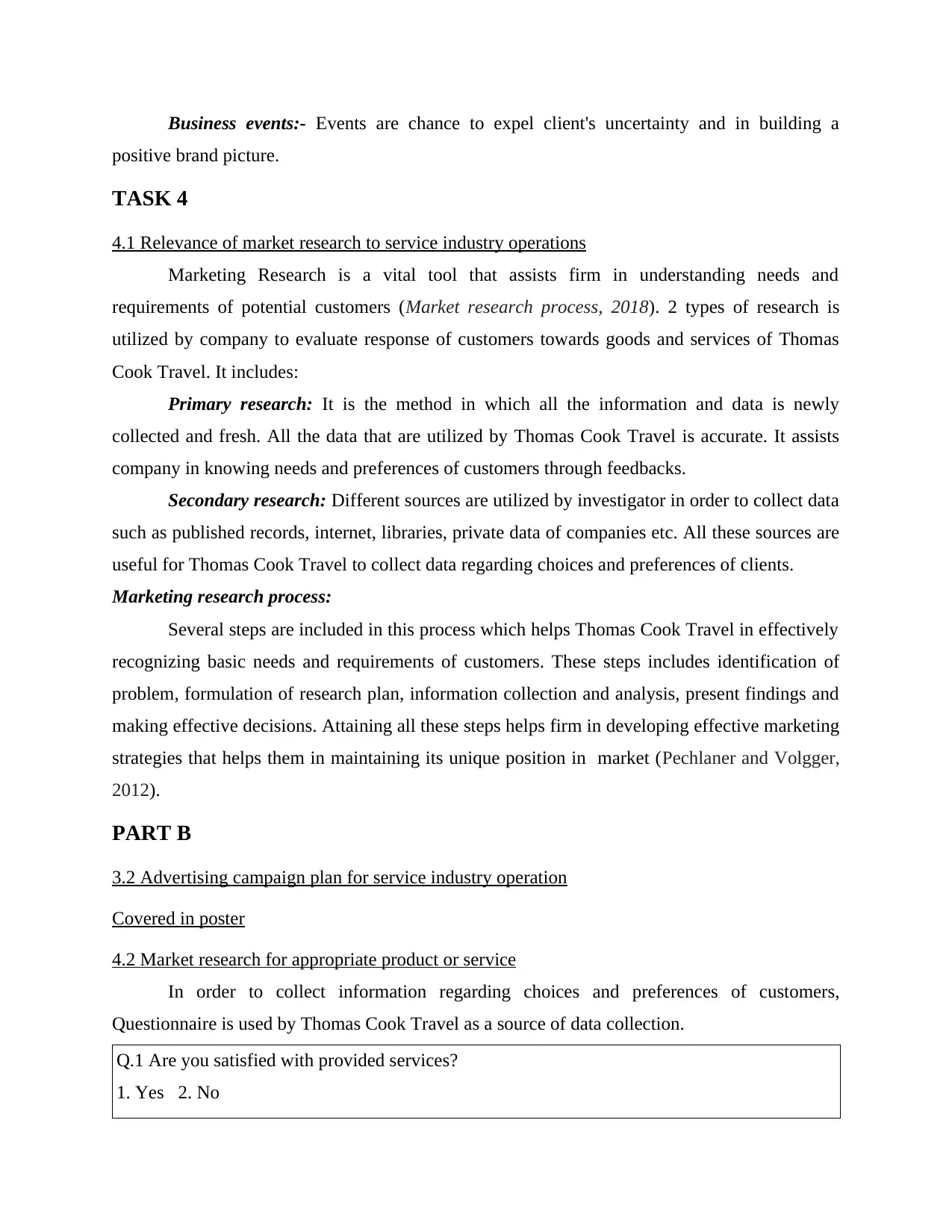
Business events:- Events are chance to expel client's uncertainty and in building a
positive brand picture.
TASK 4
4.1 Relevance of market research to service industry operations
Marketing Research is a vital tool that assists firm in understanding needs and
requirements of potential customers (Market research process, 2018). 2 types of research is
utilized by company to evaluate response of customers towards goods and services of Thomas
Cook Travel. It includes:
Primary research: It is the method in which all the information and data is newly
collected and fresh. All the data that are utilized by Thomas Cook Travel is accurate. It assists
company in knowing needs and preferences of customers through feedbacks.
Secondary research: Different sources are utilized by investigator in order to collect data
such as published records, internet, libraries, private data of companies etc. All these sources are
useful for Thomas Cook Travel to collect data regarding choices and preferences of clients.
Marketing research process:
Several steps are included in this process which helps Thomas Cook Travel in effectively
recognizing basic needs and requirements of customers. These steps includes identification of
problem, formulation of research plan, information collection and analysis, present findings and
making effective decisions. Attaining all these steps helps firm in developing effective marketing
strategies that helps them in maintaining its unique position in market (Pechlaner and Volgger,
2012).
PART B
3.2 Advertising campaign plan for service industry operation
Covered in poster
4.2 Market research for appropriate product or service
In order to collect information regarding choices and preferences of customers,
Questionnaire is used by Thomas Cook Travel as a source of data collection.
Q.1 Are you satisfied with provided services?
1. Yes 2. No
positive brand picture.
TASK 4
4.1 Relevance of market research to service industry operations
Marketing Research is a vital tool that assists firm in understanding needs and
requirements of potential customers (Market research process, 2018). 2 types of research is
utilized by company to evaluate response of customers towards goods and services of Thomas
Cook Travel. It includes:
Primary research: It is the method in which all the information and data is newly
collected and fresh. All the data that are utilized by Thomas Cook Travel is accurate. It assists
company in knowing needs and preferences of customers through feedbacks.
Secondary research: Different sources are utilized by investigator in order to collect data
such as published records, internet, libraries, private data of companies etc. All these sources are
useful for Thomas Cook Travel to collect data regarding choices and preferences of clients.
Marketing research process:
Several steps are included in this process which helps Thomas Cook Travel in effectively
recognizing basic needs and requirements of customers. These steps includes identification of
problem, formulation of research plan, information collection and analysis, present findings and
making effective decisions. Attaining all these steps helps firm in developing effective marketing
strategies that helps them in maintaining its unique position in market (Pechlaner and Volgger,
2012).
PART B
3.2 Advertising campaign plan for service industry operation
Covered in poster
4.2 Market research for appropriate product or service
In order to collect information regarding choices and preferences of customers,
Questionnaire is used by Thomas Cook Travel as a source of data collection.
Q.1 Are you satisfied with provided services?
1. Yes 2. No
⊘ This is a preview!⊘
Do you want full access?
Subscribe today to unlock all pages.

Trusted by 1+ million students worldwide
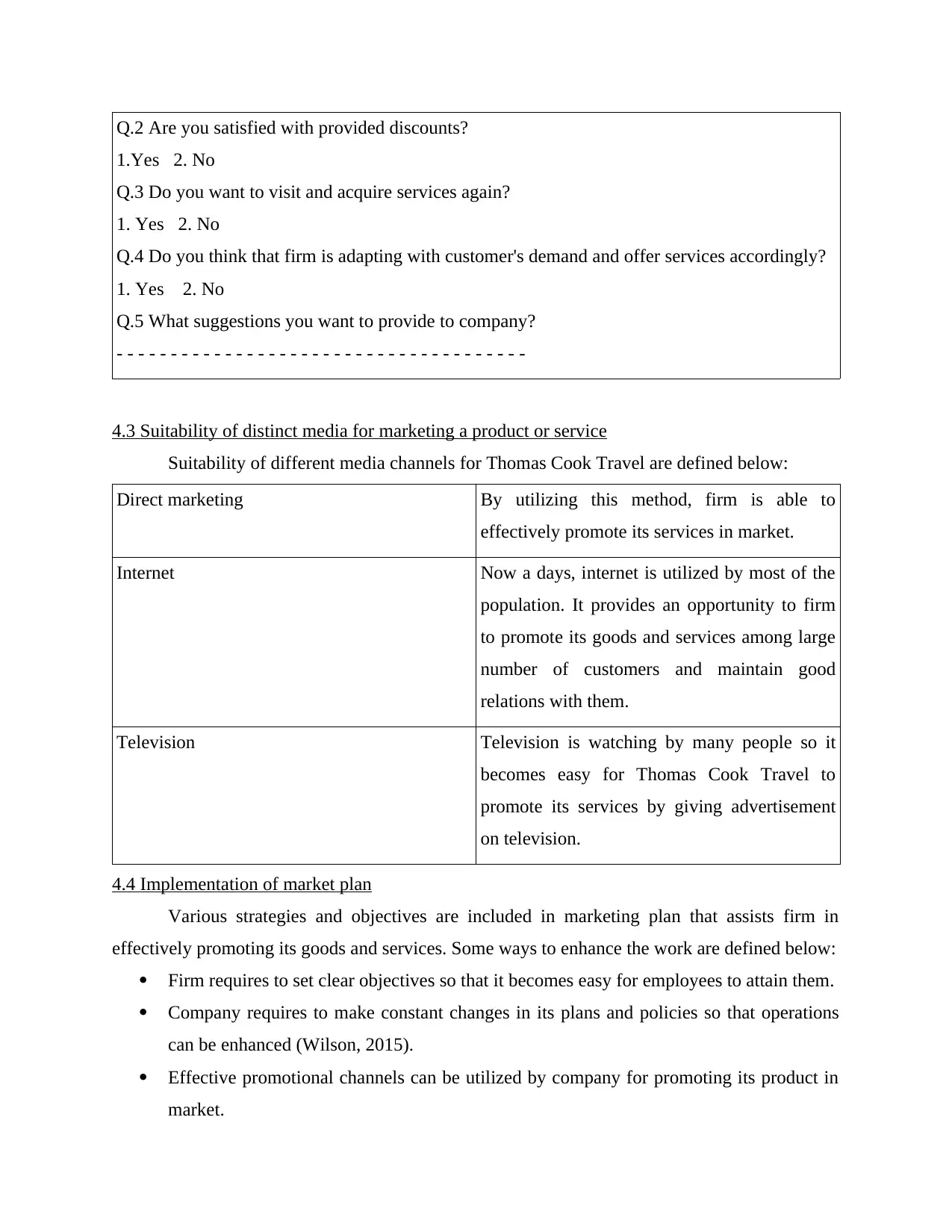
Q.2 Are you satisfied with provided discounts?
1.Yes 2. No
Q.3 Do you want to visit and acquire services again?
1. Yes 2. No
Q.4 Do you think that firm is adapting with customer's demand and offer services accordingly?
1. Yes 2. No
Q.5 What suggestions you want to provide to company?
- - - - - - - - - - - - - - - - - - - - - - - - - - - - - - - - - - - - - -
4.3 Suitability of distinct media for marketing a product or service
Suitability of different media channels for Thomas Cook Travel are defined below:
Direct marketing By utilizing this method, firm is able to
effectively promote its services in market.
Internet Now a days, internet is utilized by most of the
population. It provides an opportunity to firm
to promote its goods and services among large
number of customers and maintain good
relations with them.
Television Television is watching by many people so it
becomes easy for Thomas Cook Travel to
promote its services by giving advertisement
on television.
4.4 Implementation of market plan
Various strategies and objectives are included in marketing plan that assists firm in
effectively promoting its goods and services. Some ways to enhance the work are defined below:
Firm requires to set clear objectives so that it becomes easy for employees to attain them.
Company requires to make constant changes in its plans and policies so that operations
can be enhanced (Wilson, 2015).
Effective promotional channels can be utilized by company for promoting its product in
market.
1.Yes 2. No
Q.3 Do you want to visit and acquire services again?
1. Yes 2. No
Q.4 Do you think that firm is adapting with customer's demand and offer services accordingly?
1. Yes 2. No
Q.5 What suggestions you want to provide to company?
- - - - - - - - - - - - - - - - - - - - - - - - - - - - - - - - - - - - - -
4.3 Suitability of distinct media for marketing a product or service
Suitability of different media channels for Thomas Cook Travel are defined below:
Direct marketing By utilizing this method, firm is able to
effectively promote its services in market.
Internet Now a days, internet is utilized by most of the
population. It provides an opportunity to firm
to promote its goods and services among large
number of customers and maintain good
relations with them.
Television Television is watching by many people so it
becomes easy for Thomas Cook Travel to
promote its services by giving advertisement
on television.
4.4 Implementation of market plan
Various strategies and objectives are included in marketing plan that assists firm in
effectively promoting its goods and services. Some ways to enhance the work are defined below:
Firm requires to set clear objectives so that it becomes easy for employees to attain them.
Company requires to make constant changes in its plans and policies so that operations
can be enhanced (Wilson, 2015).
Effective promotional channels can be utilized by company for promoting its product in
market.
Paraphrase This Document
Need a fresh take? Get an instant paraphrase of this document with our AI Paraphraser

For satisfying customers, it is needed by company to provide high quality services to
customers.
Firm must made alterations in its marketing plan so that effective marketing can be done
and a unique image must be formed.
CONCLUSION
As per the above mentioned report, it has been concluded that marketing concept is vital
for business firm as it helps in effectively promote its goods and services in market. Market
research helps in determining different needs and preferences of customers that helps firm in
effectively satisfying their requirements.
\
customers.
Firm must made alterations in its marketing plan so that effective marketing can be done
and a unique image must be formed.
CONCLUSION
As per the above mentioned report, it has been concluded that marketing concept is vital
for business firm as it helps in effectively promote its goods and services in market. Market
research helps in determining different needs and preferences of customers that helps firm in
effectively satisfying their requirements.
\
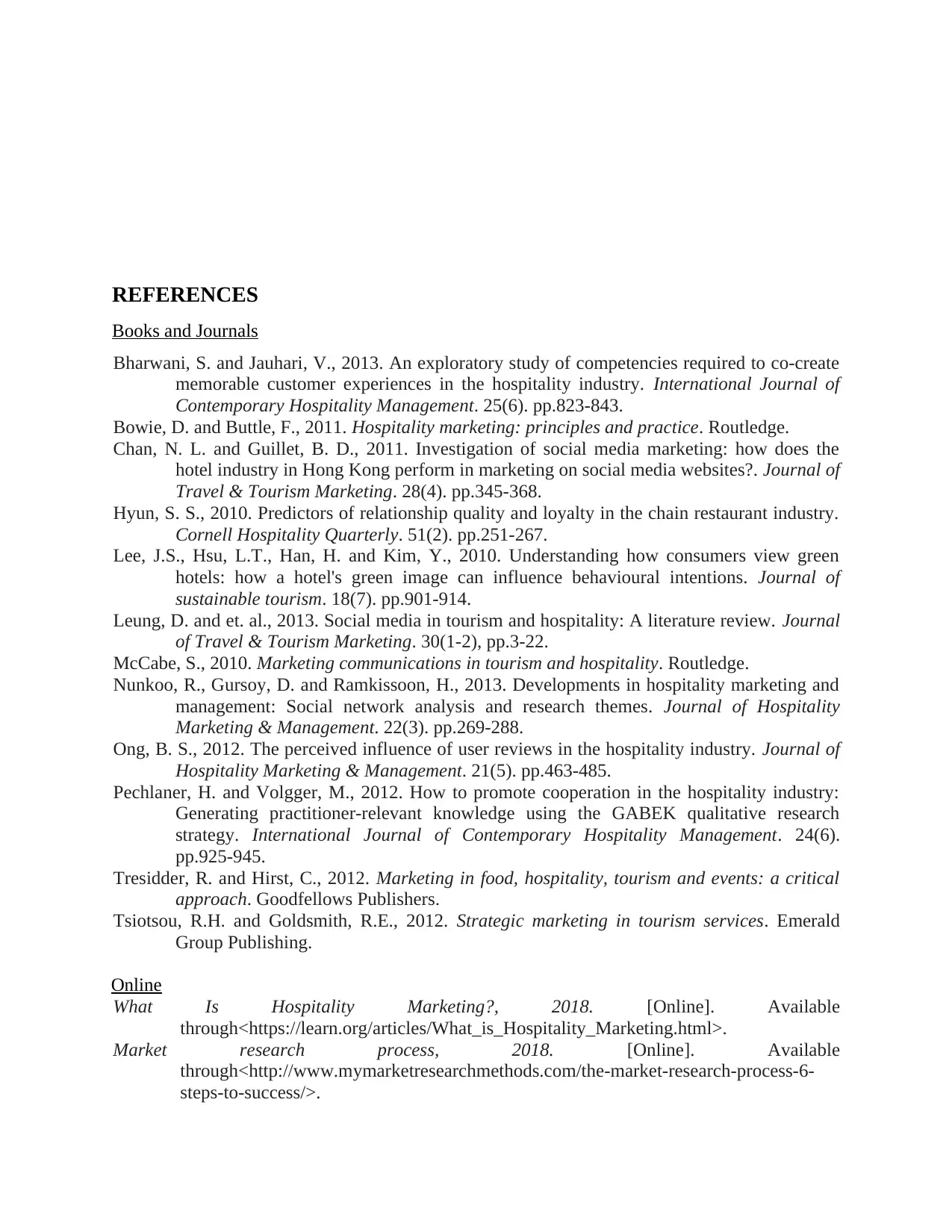
REFERENCES
Books and Journals
Bharwani, S. and Jauhari, V., 2013. An exploratory study of competencies required to co-create
memorable customer experiences in the hospitality industry. International Journal of
Contemporary Hospitality Management. 25(6). pp.823-843.
Bowie, D. and Buttle, F., 2011. Hospitality marketing: principles and practice. Routledge.
Chan, N. L. and Guillet, B. D., 2011. Investigation of social media marketing: how does the
hotel industry in Hong Kong perform in marketing on social media websites?. Journal of
Travel & Tourism Marketing. 28(4). pp.345-368.
Hyun, S. S., 2010. Predictors of relationship quality and loyalty in the chain restaurant industry.
Cornell Hospitality Quarterly. 51(2). pp.251-267.
Lee, J.S., Hsu, L.T., Han, H. and Kim, Y., 2010. Understanding how consumers view green
hotels: how a hotel's green image can influence behavioural intentions. Journal of
sustainable tourism. 18(7). pp.901-914.
Leung, D. and et. al., 2013. Social media in tourism and hospitality: A literature review. Journal
of Travel & Tourism Marketing. 30(1-2), pp.3-22.
McCabe, S., 2010. Marketing communications in tourism and hospitality. Routledge.
Nunkoo, R., Gursoy, D. and Ramkissoon, H., 2013. Developments in hospitality marketing and
management: Social network analysis and research themes. Journal of Hospitality
Marketing & Management. 22(3). pp.269-288.
Ong, B. S., 2012. The perceived influence of user reviews in the hospitality industry. Journal of
Hospitality Marketing & Management. 21(5). pp.463-485.
Pechlaner, H. and Volgger, M., 2012. How to promote cooperation in the hospitality industry:
Generating practitioner-relevant knowledge using the GABEK qualitative research
strategy. International Journal of Contemporary Hospitality Management. 24(6).
pp.925-945.
Tresidder, R. and Hirst, C., 2012. Marketing in food, hospitality, tourism and events: a critical
approach. Goodfellows Publishers.
Tsiotsou, R.H. and Goldsmith, R.E., 2012. Strategic marketing in tourism services. Emerald
Group Publishing.
Online
What Is Hospitality Marketing?, 2018. [Online]. Available
through<https://learn.org/articles/What_is_Hospitality_Marketing.html>.
Market research process, 2018. [Online]. Available
through<http://www.mymarketresearchmethods.com/the-market-research-process-6-
steps-to-success/>.
Books and Journals
Bharwani, S. and Jauhari, V., 2013. An exploratory study of competencies required to co-create
memorable customer experiences in the hospitality industry. International Journal of
Contemporary Hospitality Management. 25(6). pp.823-843.
Bowie, D. and Buttle, F., 2011. Hospitality marketing: principles and practice. Routledge.
Chan, N. L. and Guillet, B. D., 2011. Investigation of social media marketing: how does the
hotel industry in Hong Kong perform in marketing on social media websites?. Journal of
Travel & Tourism Marketing. 28(4). pp.345-368.
Hyun, S. S., 2010. Predictors of relationship quality and loyalty in the chain restaurant industry.
Cornell Hospitality Quarterly. 51(2). pp.251-267.
Lee, J.S., Hsu, L.T., Han, H. and Kim, Y., 2010. Understanding how consumers view green
hotels: how a hotel's green image can influence behavioural intentions. Journal of
sustainable tourism. 18(7). pp.901-914.
Leung, D. and et. al., 2013. Social media in tourism and hospitality: A literature review. Journal
of Travel & Tourism Marketing. 30(1-2), pp.3-22.
McCabe, S., 2010. Marketing communications in tourism and hospitality. Routledge.
Nunkoo, R., Gursoy, D. and Ramkissoon, H., 2013. Developments in hospitality marketing and
management: Social network analysis and research themes. Journal of Hospitality
Marketing & Management. 22(3). pp.269-288.
Ong, B. S., 2012. The perceived influence of user reviews in the hospitality industry. Journal of
Hospitality Marketing & Management. 21(5). pp.463-485.
Pechlaner, H. and Volgger, M., 2012. How to promote cooperation in the hospitality industry:
Generating practitioner-relevant knowledge using the GABEK qualitative research
strategy. International Journal of Contemporary Hospitality Management. 24(6).
pp.925-945.
Tresidder, R. and Hirst, C., 2012. Marketing in food, hospitality, tourism and events: a critical
approach. Goodfellows Publishers.
Tsiotsou, R.H. and Goldsmith, R.E., 2012. Strategic marketing in tourism services. Emerald
Group Publishing.
Online
What Is Hospitality Marketing?, 2018. [Online]. Available
through<https://learn.org/articles/What_is_Hospitality_Marketing.html>.
Market research process, 2018. [Online]. Available
through<http://www.mymarketresearchmethods.com/the-market-research-process-6-
steps-to-success/>.
⊘ This is a preview!⊘
Do you want full access?
Subscribe today to unlock all pages.

Trusted by 1+ million students worldwide
1 out of 13
Related Documents
Your All-in-One AI-Powered Toolkit for Academic Success.
+13062052269
info@desklib.com
Available 24*7 on WhatsApp / Email
![[object Object]](/_next/static/media/star-bottom.7253800d.svg)
Unlock your academic potential
Copyright © 2020–2025 A2Z Services. All Rights Reserved. Developed and managed by ZUCOL.





